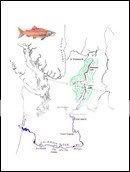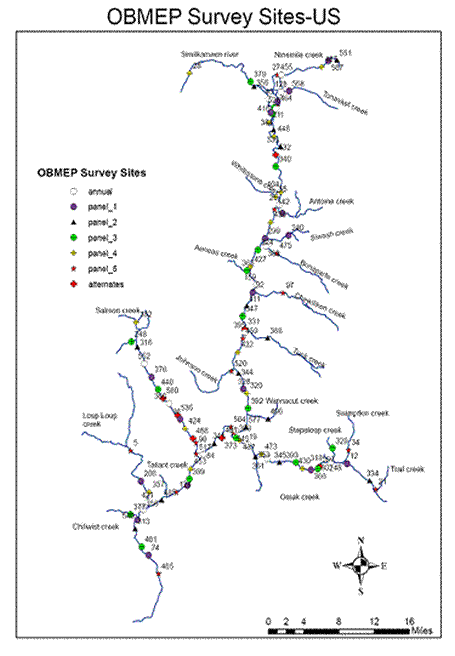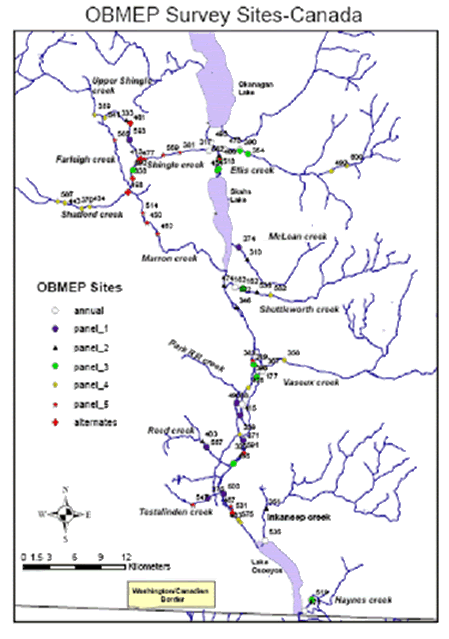twinwinds
Active Member
16:25/02. RECORD COLUMBIA RIVER SOCKEYE RUN: Fishery managers have had difficulty estimating the Columbia sockeye run and this year predicted the count at Bonneville Dam would be 125,000 fish. But 30,374 sockeye passed through on 23 June, the most in a single day since the dam was built in 1938. Two days later the estimate for the year doubled, to 250,000 sockeye. On Saturday, the run exceeded this estimate and reached 329,579 fish. Before dams were built on the Columbia and Snake rivers, sockeye run estimates reached 3 million fish. The run almost died after the dams came in and then, with much help, have now started a comeback.
The size of this summer's run -- there were 177,000 sockeye in 2009, 213,000 in 2008 but as few as 13,000 in 1998 -- is causing a stir up and down the river. Native Americans are selling more fish earlier, and the run is open to sport fishermen from the mouth of the Columbia to the Oregon/Washington border. Residents around Lake Wenatchee, WA, await word on whether they will be able to fish for sockeye again, and biologists hope the run up the Columbia means more endangered sockeye will turn up the Snake River for central Idaho.
Experts point to many reasons for increasing runs, among them improvements to dams and hatchery practices, better tributary habitat and increased smolt releases. But the primary reasons, scientists say, are Court-ordered increased spills from dams in the spring, when smolts migrate downstream, and improved conditions in the ocean where salmon spend two to four years growing up. "If the spill is good and ocean conditions right, there are good results," says Chris Kern, an Oregon Department of Fish & Wildlife biologist who monitors the Columbia River. This year the return of spring chinook was 40 percent higher than the 10-year average, and the runs of summer chinook and steelhead under way are expected to be higher than normal. Most of these fish are, however, hatchery fish. The comparable wild fish runs are still federally protected as “endangered†or threatened under the federal Endangered Species Act.
In Bristol Bay, Alaska, the sockeye salmon catch totals exceeded 1 million and the Alaska Department of Fish & Game is forecasting a total sockeye salmon run of nearly 40 million fish, with a commercial harvest of nearly 32 million. It seems sockeyes are doing well in the northern states and this demonstrates how the salmon natural resource can be recovered and sustained. To read the full 4 July article about Columbia River sockeye in The Oregonian by Quinton Smith go to: www.oregonlive.com/environment/index.ssf/2010/07/record_columbia_river_sockeye.html
To read an article about the Bristol Bay sockeye catch in the 2 July Alaska Journal of Commerce by Maggie Wall go to: www.alaskajournal.com/stories/070210/fis_bbc.shtml . To see a series of articles about salmon in Alaska go here: www.theatlantic.com/food/archive/2010/07/salmon-extravaganza-part-i/59041 and here www.theatlantic.com/food/archive/2010/07/fighting-for-salmon/59091 .
This publication, however, may be freely reproduced and circulated without copyright restriction. Articles taken from Fishlink Sublegals may be freely reposted or reprinted with attribution to “Fishlink Sublegals.â€
The size of this summer's run -- there were 177,000 sockeye in 2009, 213,000 in 2008 but as few as 13,000 in 1998 -- is causing a stir up and down the river. Native Americans are selling more fish earlier, and the run is open to sport fishermen from the mouth of the Columbia to the Oregon/Washington border. Residents around Lake Wenatchee, WA, await word on whether they will be able to fish for sockeye again, and biologists hope the run up the Columbia means more endangered sockeye will turn up the Snake River for central Idaho.
Experts point to many reasons for increasing runs, among them improvements to dams and hatchery practices, better tributary habitat and increased smolt releases. But the primary reasons, scientists say, are Court-ordered increased spills from dams in the spring, when smolts migrate downstream, and improved conditions in the ocean where salmon spend two to four years growing up. "If the spill is good and ocean conditions right, there are good results," says Chris Kern, an Oregon Department of Fish & Wildlife biologist who monitors the Columbia River. This year the return of spring chinook was 40 percent higher than the 10-year average, and the runs of summer chinook and steelhead under way are expected to be higher than normal. Most of these fish are, however, hatchery fish. The comparable wild fish runs are still federally protected as “endangered†or threatened under the federal Endangered Species Act.
In Bristol Bay, Alaska, the sockeye salmon catch totals exceeded 1 million and the Alaska Department of Fish & Game is forecasting a total sockeye salmon run of nearly 40 million fish, with a commercial harvest of nearly 32 million. It seems sockeyes are doing well in the northern states and this demonstrates how the salmon natural resource can be recovered and sustained. To read the full 4 July article about Columbia River sockeye in The Oregonian by Quinton Smith go to: www.oregonlive.com/environment/index.ssf/2010/07/record_columbia_river_sockeye.html
To read an article about the Bristol Bay sockeye catch in the 2 July Alaska Journal of Commerce by Maggie Wall go to: www.alaskajournal.com/stories/070210/fis_bbc.shtml . To see a series of articles about salmon in Alaska go here: www.theatlantic.com/food/archive/2010/07/salmon-extravaganza-part-i/59041 and here www.theatlantic.com/food/archive/2010/07/fighting-for-salmon/59091 .
This publication, however, may be freely reproduced and circulated without copyright restriction. Articles taken from Fishlink Sublegals may be freely reposted or reprinted with attribution to “Fishlink Sublegals.â€





